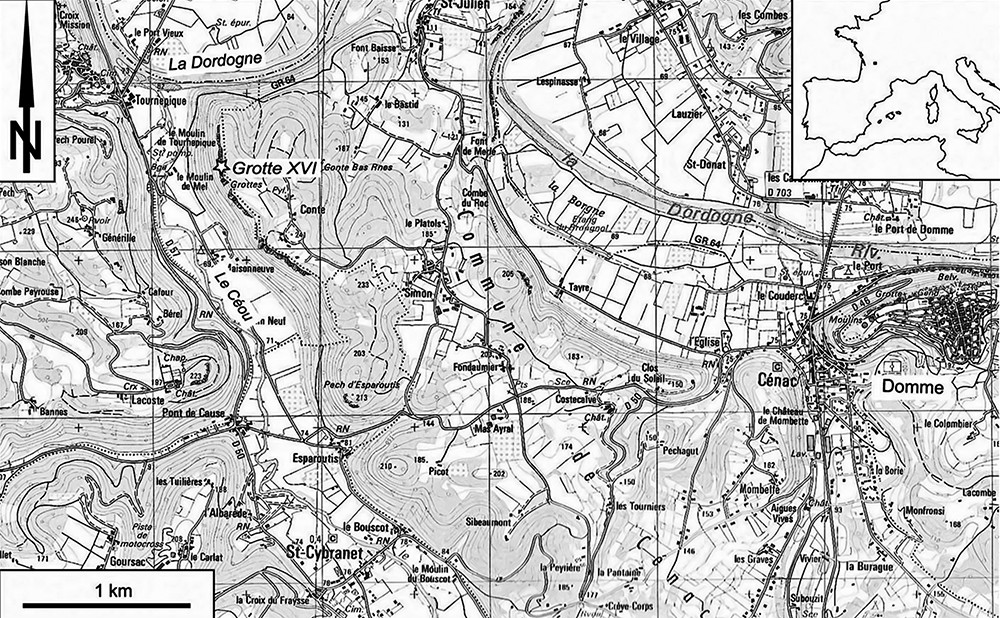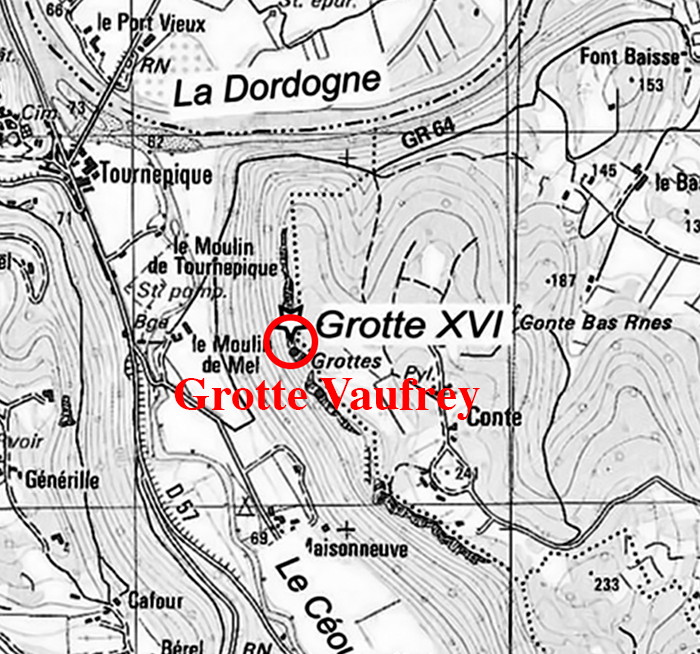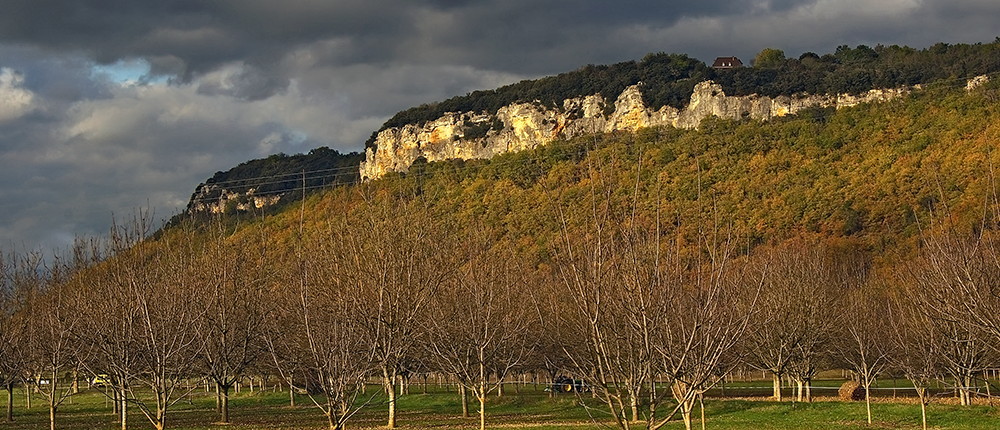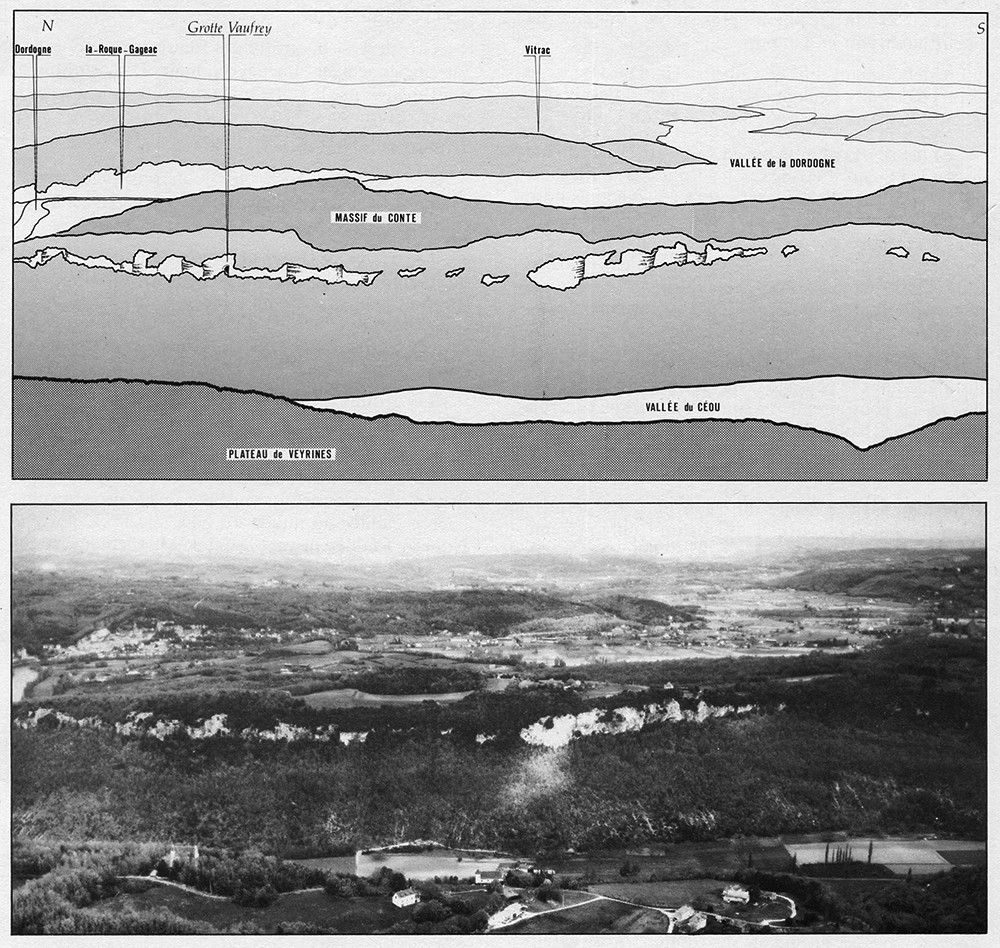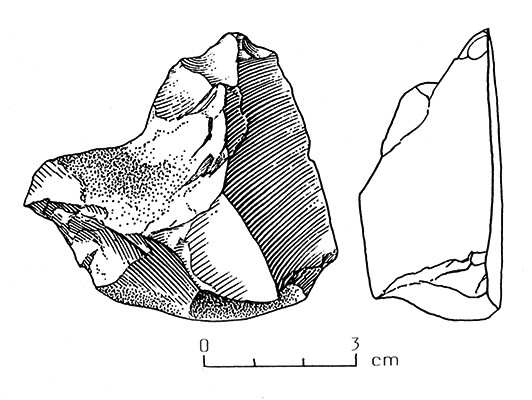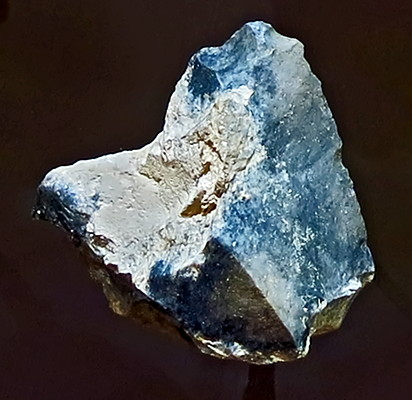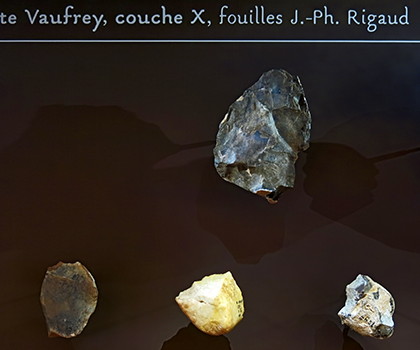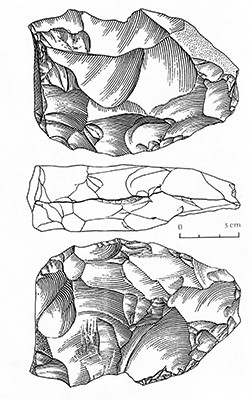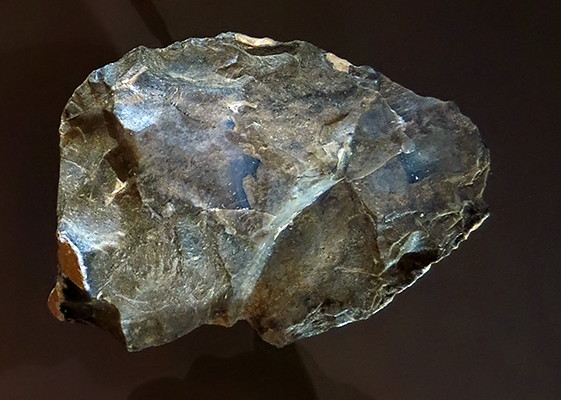Back to Don's Maps
 Back to Archaeological Sites
Back to Archaeological Sites
La Grotte Vaufrey
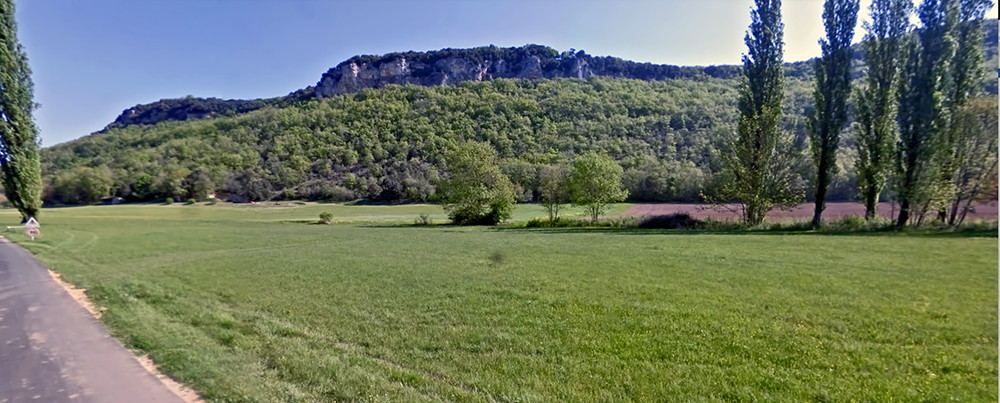
Cliffline of the Falaises du Conte. Grotte Vaufrey is on the far left of the cliffline in this image.
Source: Google Street View
La Grotte Vaufrey is one of 22 caves and rock shelters known to dot the limestone cliff on the east side of the Céou River just south of its junction with the Dordogne River in Southwestern France. Excavated under the direction of Jean-Philippe Rigaud between 1969 and 1982, this site proved to contain a remarkable sequence of Acheulean and Mousterian occupations distributed across 12 major depositional units, couches I - XII.Text above: Grayson and Delpech (1994)
La Grotte Vaufrey is the immediate neighbour of la Grotte XVI shown here, on the southern side of it.
Source of map: Kervazo et Texier (2009-2010).
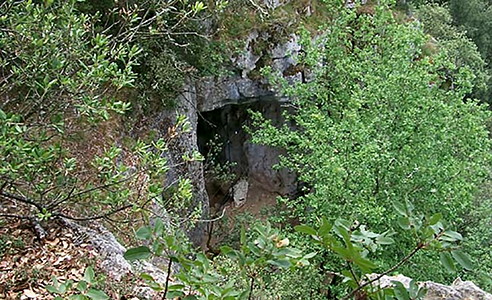
La Grotte Vaufrey entrance.
Photo: http://www.oldstoneage.com/pechiv/2002/days_off_in_france_archaeology.shtml
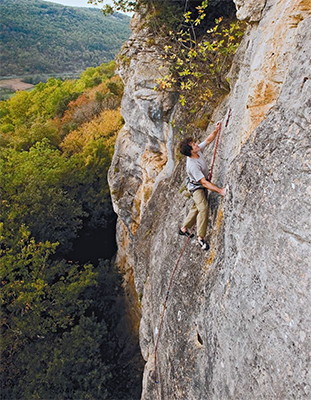
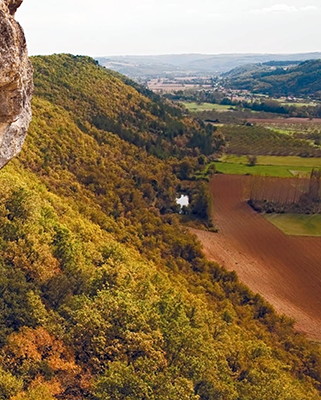
Both La Grotte Vaufrey and la Grotte XVI are part of the Falaises du Conte, a favourite rock climbing site in the region.
The caves and their terraces are about 30 metres above the valley of Céou, and would have given a superb view of approaching game travelling down the Céou to reach the valley of the Dordogne, especially when we consider the stunted vegetation of the ice ages.
Photo: http://www.les-artsdelagrimpe.com/images/techniques/escalademag_27.pdf
Position of the caves on the Falaises du Conte, the western face of the Massif du Conte, with the location of la Grotte Vaufrey marked.
Photo: after Guadelli J.-L. et Rigaud (1995)
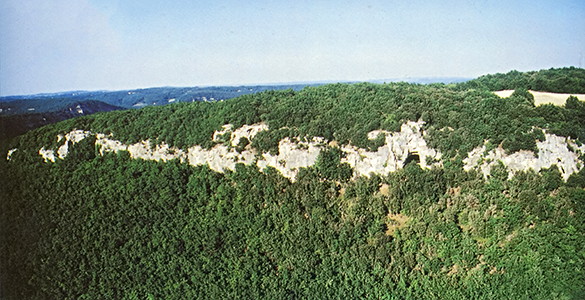
Aerial view of the the Falaises du Conte.
Photo: Rigaud (1988)
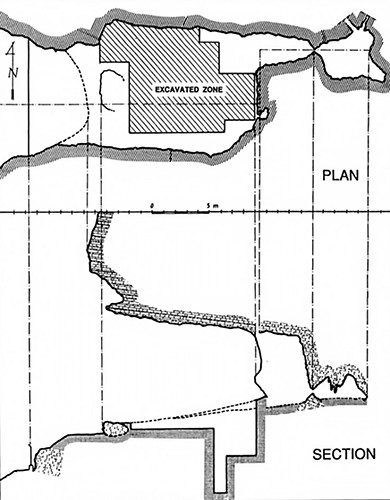
Plan and section of the excavated zone in the Grotte Vaufrey.
Source: Mellars (1996), after Rigaud (1988)
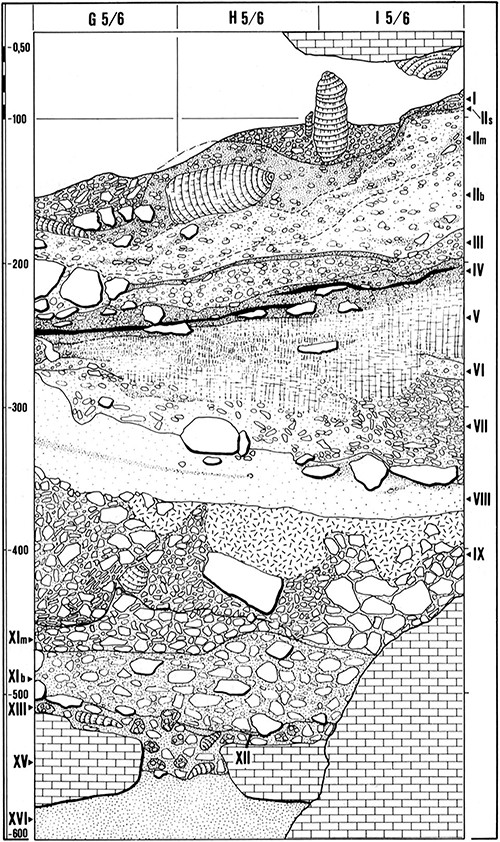
Schematic image of the stratigraphy at Grotte Vaufrey. The Roman numbers represent the layers.
The site consists of sixteen archaeological layers of which the oldest five are layers deposited before hominin occupation.
On top of the first layer a thick layer of stalagmite material has been deposited. Between layers III and IV a similar layer has been deposited and layer XIII is also a stalagmite layer.
Some layers possess characteristics of cave collapses throughout the occupation period and before.
These collapses have improved the accuracy of the division between the layers.
Source: Kervazo et Laville (1989)
Text and proximal source: Bezemer (2012)
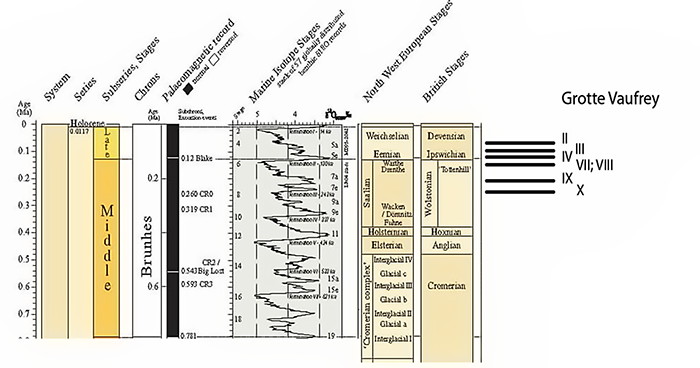
At Grotte Vaufrey there have been several studies done to date the layers. These used the methods of thermoluminescence dating and uranium series dating.
The diagram at left shows the dates of some of the archaeological layers of Grotte Vaufrey placed in the chronostratigraphical table.
Source: Matthijs Hattinga Verschure in Bezemer (2012)
Text: Bezemer (2012).
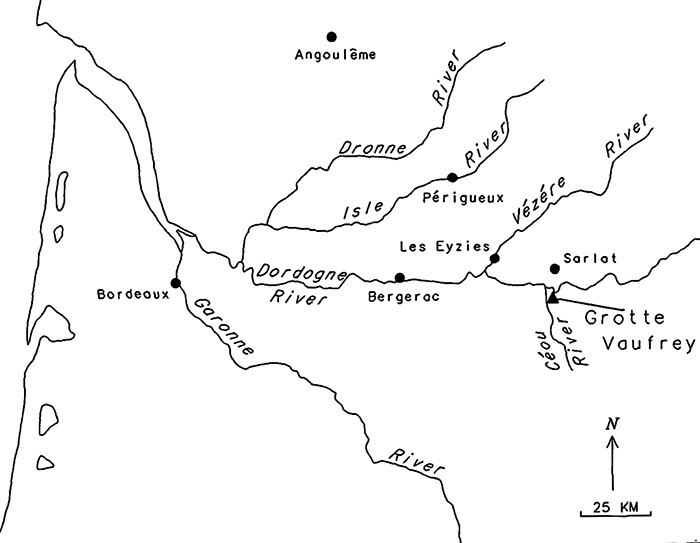
Location of la Grotte Vaufrey.
Photo: Grayson (1994),
Cliff line of the Falaises du Conte, showing here the southern section, with the large house on top of the plateau visible, marked as '24' on the topographical map.
Photo: Michel Chanaud
Permission: Creative Commons Attribution-Share Alike 3.0 Unported license.
Source: Wikipedia
Northern section of the cliffline, in the Grotte Vaufrey location. La Grotte Vaufrey is towards the left at the immediate base of these cliffs.
Source: Google Street View
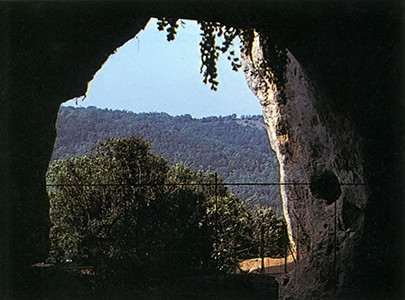
The view from within the cave.
Photo: Rigaud (1988)
Animal bones found in the deposits at Grotte Vaufrey
| Animals at Grotte Vaufrey | ||||
|---|---|---|---|---|
| Name | Common Name | Image | Source | |
| Ungulates | ||||
| Bos primigenius | Aurochs | 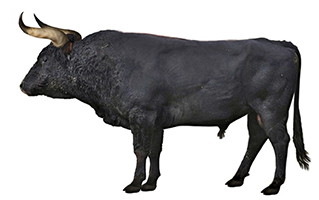 |
Photo: Jaap Rouwenhorst GIMP modifications: D Foidl CC BY-SA 3.0 |
|
| Bison priscus | Steppe Bison | 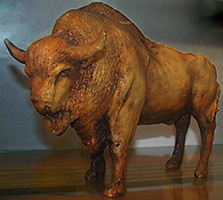 |
Photo: Don Hitchcock Source: Display at Les Combarelles |
|
| Rangifer tarandus | Reindeer | 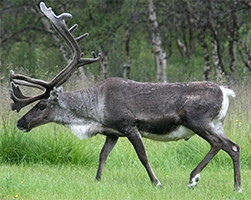 |
Are G Nilsen CC BY-SA 3.0 |
|
| Equus ferus ferus | Wild Horse, Tarpan | 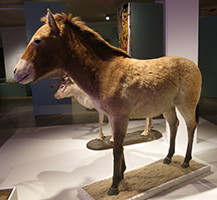 |
Photo: Don Hitchcock Source: Display at LVR-Landesmuseum Bonn, Germany |
|
| Cervus elaphus | Red Deer | 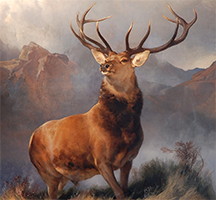 |
Edwin Henry Landseer (1802–1873) Public Domain |
|
| Capreolus capreolus | Roe Deer | 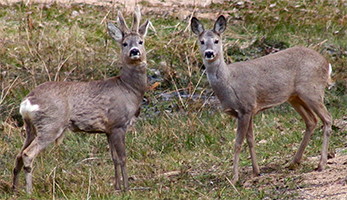 |
Jojo CC BY-SA 3.0 |
|
| Sus scrofa | Boar | 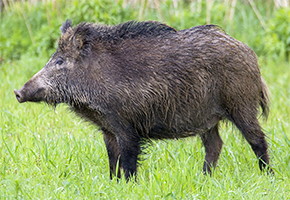 |
Jerzy Strzelecki CC BY-SA 3.0 |
|
| Stephanorhinus kirchbergensis | Rhinoceros | 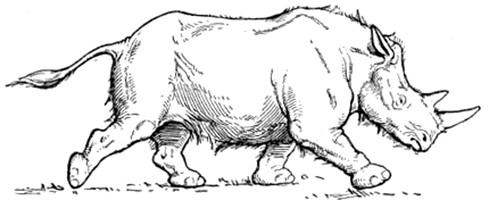 |
H. Osborn (1916) Public Domain |
|
| Capra ibex | Ibex |  |
Manfred Werner - Tsui CC BY-SA 3.0 |
|
| Rupicapra rupicapra | Chamois |  |
Manfred Werner - Tsui CC BY-SA 3.0 |
|
| Hemitragus jemlahicus | Tahr | 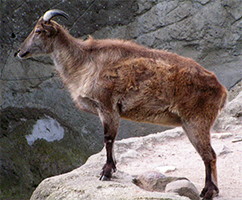 |
Finanzer CC BY-SA 3.0 |
|
| Carnivores | ||||
| Meles meles | Badger |  |
BadgerHero CC BY-SA 3.0 |
|
| Ursus arctos | Bear |  |
Iconographia Zoologica (1700 - 1880) Public Domain |
|
| Cuon alpinus | Dhole | 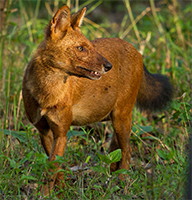 |
N. A. Naseer / www.nilgirimarten.com / naseerart@gmail.com CC BY-SA 2.5 |
|
| Canidae vulpes | Fox |  |
Shiretoko-Shari Tourist Association Free |
|
| Lynx lynx | Lynx |  |
mpiet (http://www.mindbox.at/gallery/) CC BY-SA 2.0 |
|
| Canis lupus | Wolf |  |
[1] Creative Commons Attribution 2.0 Generic license. |
|
Fish bones found in the deposits at Grotte Vaufrey
| Fish at Grotte Vaufrey | ||||
|---|---|---|---|---|
| Name | Common Name | Image | Source | |
| Salmo salar | Atlantic salmon |  |
Knepp, Timothy Public Domain |
|
| Salmo trutta | Brown Trout | 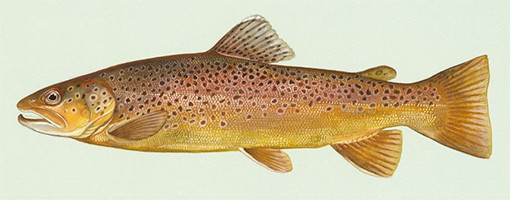 |
Duane Raver Public Domain |
|
| Thymallus thymallus | Grayling | 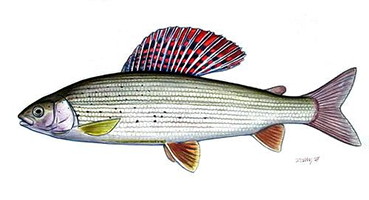 |
Zsoldos Márton Free |
|
| Leuciscus cephalus | Chub | 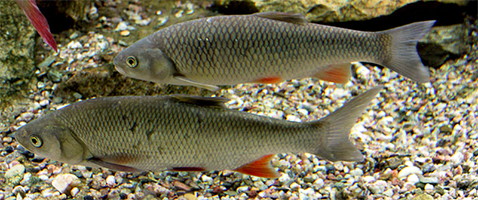 |
Karelj Public Domain |
|
| Leuciscus leuciscus | Common Dace | 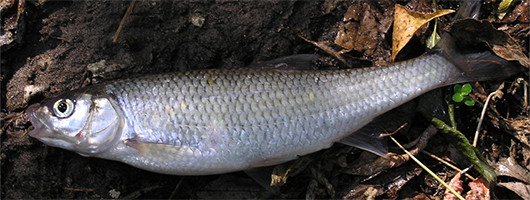 |
Alexander Suvorov Public Domain |
|
| Esox lucius | Pike |  |
Timothy Knepp Public Domain |
|
| Alburnus alburnus | Common Bleak | 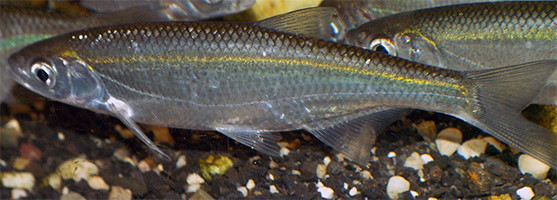 |
Piet Spaans CC BY-SA 2.5 |
|
| Perca fluviatilis | Perch, Redfin | 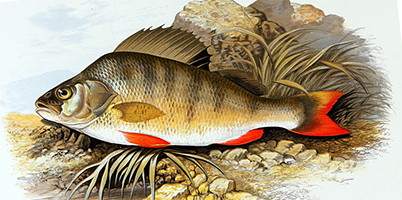 |
A. Lydon (1836-1917) Public Domain |
|
| Anguilla anguilla | European Eel |  |
Gerard M CC BY-SA 3.0 |
|
Aerial photograph showing the position of Grotte Vaufrey.
Photo: Rigaud (1988)
Grotte Vaufrey opens to the west in a wide porch 15 m deep and wide. The main chamber is 22 metres deep and extends north-east through a diverticule a few metres wide communicating through a narrow opening to a chamber 4 metres long and 3 metres wide, from which two narrow galleries go towards the north-east in which all progression is stopped after ten metres because of the narrowness of the passage.Text above: Guadelli J.-L. et Rigaud (1995)
The main chamber is a deep abri, but in fact it results from the receding opening of the cliff, a karstic chamber that developed at the base of the Coniacien (Upper Cretaceous) limestone, which has resulted in a thick crystallised calcite floor coating to the left of the current entry. This room seems to have developed by reason of two parallel fractures oriented roughly east-west. The more important fracture interleaves with the north wall of the cave.
We can estimate that the lowest part (which we did not excavate because of the sterile filling), is in the centre of the chamber close to the north wall of the room. At the bottom of the cave, a small cavity of one square metre was found at the top of the filling. Unfortunately, it was totally emptied of the sediments it contained.
On the left side of the entrance porch, another cavity had its opening 3 metres above the current floor. No bigger than the previous cavity, it was 80 cm high, and contained some remains sealed on the rock by a carbonate concretion 2 to 3 cm thick.
The first works were done in this cavity by R. Vaufrey in 1930 and, until 1965, the cave attracted by its size many teams of boy scouts who found in the search for bones, flint and pottery, a palliative for idleness on rainy days. They destroyed a volume that can be estimated at 30 cubic metres of archaeological levels. In 1969, the entrance to the cave was fenced and excavation work continued until 1982. A sondage of 10 square metres was conducted in the deep levels (layers IX to XVI) to reach, in 1980, the rocky base and sterile sandy levels attributable to a very old filling of the cave.
Layer XI Lower
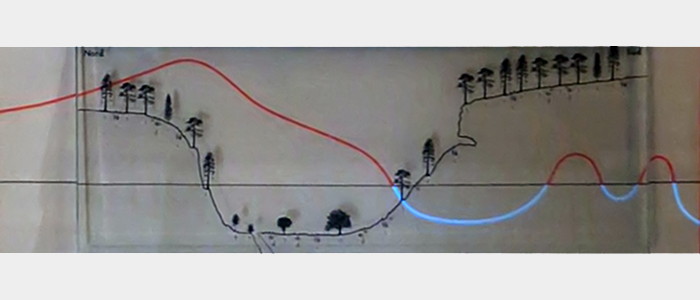
The temperatures of the lower section of Layer XI, circa 425 000 BP, were predominantly warm, with some cold times later in the deposition.
Fauna included Deer and the Mosbach horse, Equus cabalIus mosbachensis
Rephotography of the display: Don Hitchcock 2014
Source and text: Adapted from the display, le Musée National de Préhistoire, Les Eyzies-de-Tayac
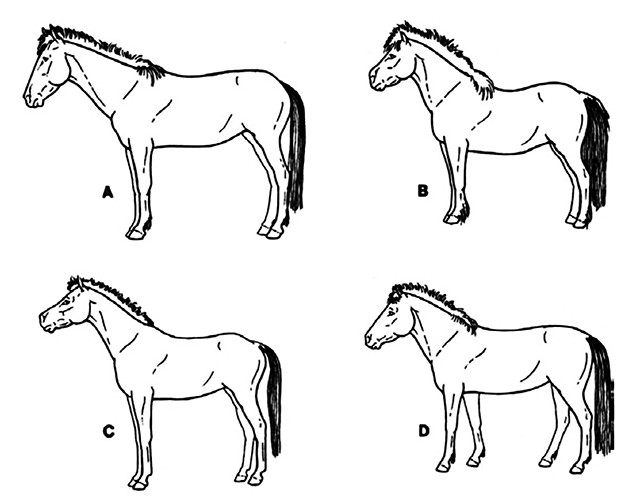
Reconstructions of four subspecies of Equus cabalIus, based on fossil remains, old photographs, and the appearance of probable domestic descendants from the same geographic areas.
A. Mosbach or Central European horse, Equus cabalIus mosbachensis
B. Northwestern European horse, Equus cabalIus caballus - the dwarfed insular pony is illustrated
C. AfroTurkic horse, Equus cabalIus pumpelli
D. Tarpan, Equus cabalIus ferus
Photo and text: Bennett (1992)
Proximal Source: Bennett and Hoffmann (1999)
Flora included the Norway Spruce (Picea abies), Silver Fir (Abies alba), Scots pine (Pinus sylvestris), White Birch (Betula pubescens), Common Hazel Nut (Corylus avellana), Downy Oak (Quercus pubescens), Caucasian wingnut (Pterocarya fraxinifolia), Lettuce, Chicory, Dandelion, Salsify family (Cichorieae), and grasses.
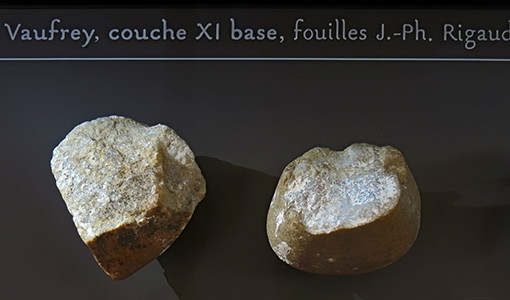
Tools from Grotte Vaufrey, lower part of Layer XI, circa 425 000 BP.
Chopping tools.
Photo and tool identification: Don Hitchcock 2014
Source: Original, le Musée National de Préhistoire, Les Eyzies-de-Tayac
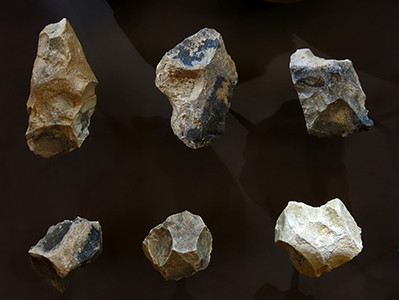
Tools from Grotte Vaufrey, lower part of Layer XI, circa 425 000 BP.
These appear to be cores from which flakes have been struck.
Photo and tool identification: Don Hitchcock 2014
Source: Original, le Musée National de Préhistoire, Les Eyzies-de-Tayac
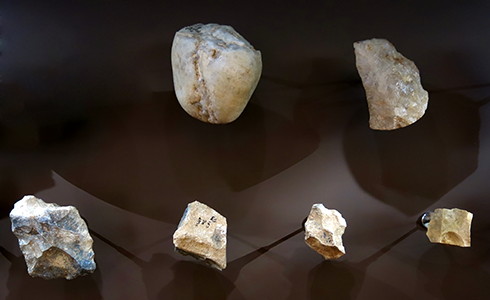
Tools from Grotte Vaufrey, lower part of Layer XI, circa 425 000 BP.
Hammer stone or chopping tool, top centre, a hand held knife of quartzite at top right, and scrapers.
The knife is interesting by reason of its very smoothly curved lower end (in this image).
A burin second from the left, bottom row, is more easily discerned in the image immediately below.
Photo and tool identification: Don Hitchcock 2014
Source: Original, le Musée National de Préhistoire, Les Eyzies-de-Tayac
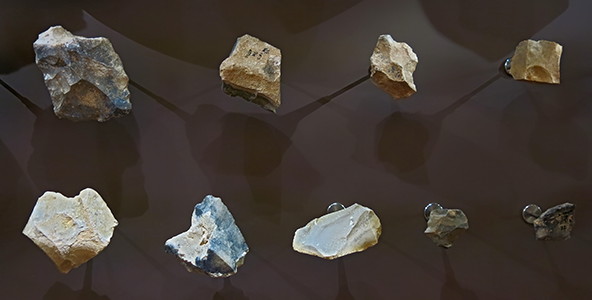
Tools from Grotte Vaufrey, lower part of Layer XI, circa 425 000 BP.
Some small scrapers, typical of the Mousterian, with possibly a core at top left.
Notched scrapers at the bottom far left and second bottom left, apparently of the La Quina type, with a Clactonian notch. Clactonian notches are large notches obtained from a single stroke of the hammer, sometimes corrected by small secondary alterations, which may also be due to use.
There is a well made end scraper (grattoir) made on a thin flake at bottom centre, as well as a burin on the top row, second from left.
The tool second from the right, bottom row, may be a burin. As always, click to get a larger and higher definition image.
Photo and tool identification: Don Hitchcock 2014
Source: Original, le Musée National de Préhistoire, Les Eyzies-de-Tayac
Tool from Grotte Vaufrey, lower part of Layer XI, circa 425 000 BP.
Flake.
Drawing and text: Rigaud (1988)
Photo: Don Hitchcock 2014
Source: Original, le Musée National de Préhistoire, Les Eyzies-de-Tayac
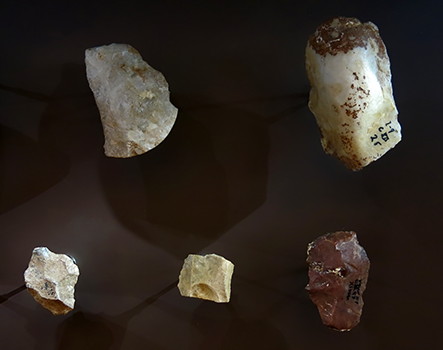
Tools from Grotte Vaufrey, lower part of Layer XI, circa 425 000 BP.
Top row:
(left): hand held quartzite knife, interesting by reason of its perfect arcuate lower end (in this image). It is difficult to see how this could have been knapped, it may be just the way the flake came off a rounded pebble core.
(right): Keeled end scraper, but very smoothly finished on the top, possibly it is the original surface from the flint pebble used.
Bottom row:
(left): Apparently a broken drill or burin.
(centre): A flake which has been truncated on two sides, to create a scraper.
(right): Red jasper end scraper made on a flake.
Photo and tool identification: Don Hitchcock 2014
Source: Original, le Musée National de Préhistoire, Les Eyzies-de-Tayac
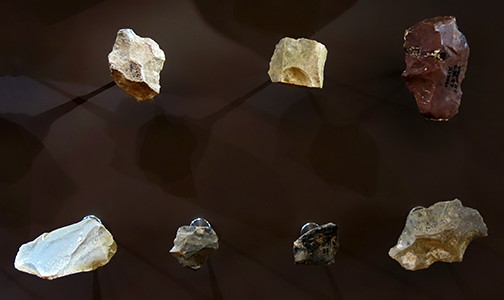
Tools from Grotte Vaufrey, lower part of Layer XI, circa 425 000 BP.
Top row:
(left): Apparently a broken drill or burin.
(centre): A flake which has been truncated on two sides, to create a scraper.
(right): Red jasper end scraper made on a flake.
Bottom row:
(left) Well made end scraper (grattoir) made on a thin flake.
(centre left) possibly a burin.
(centre right) scraper.
(right) small multi use tool - scraper and burin.
Photo and tool identification: Don Hitchcock 2014
Source: Original, le Musée National de Préhistoire, Les Eyzies-de-Tayac
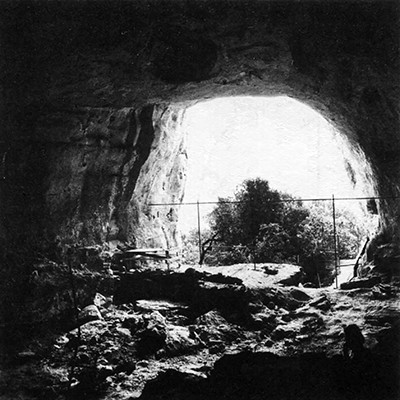
View of the entrance to Grotte Vaufrey from the inside.
Photo: Rigaud (1988)
Layer XI Upper
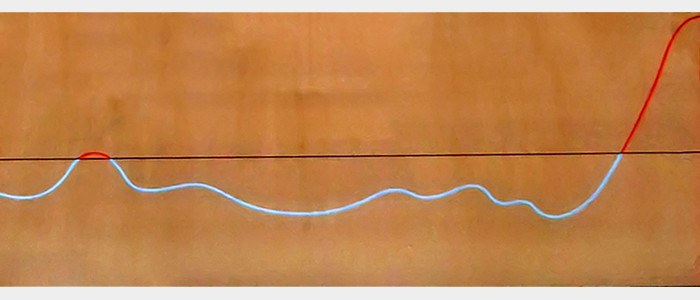
The temperatures of the upper section of Layer XI, circa 375 000 BP, were predominantly cold, with a warm period late in the deposition.
Layer XI upper included fauna such as the Mosbach Horse, Aurochs, Bison, Deer, Etruscan Rhinoceros, Roe Deer, Boar, and Thar.
Rephotography of the display: Don Hitchcock 2014
Source and text: Adapted from the display, le Musée National de Préhistoire, Les Eyzies-de-Tayac
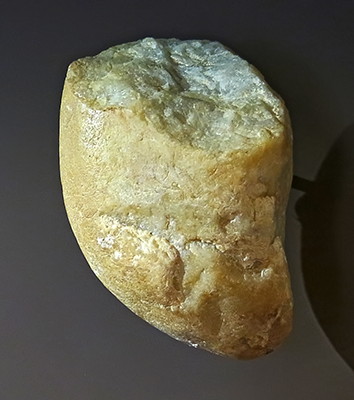
Tool from Grotte Vaufrey, upper part of Layer XI, circa 375 000 BP.
Possibly a broken hammer stone, or a chopping tool.
Photo and tool identification: Don Hitchcock 2014
Source: Original, le Musée National de Préhistoire, Les Eyzies-de-Tayac
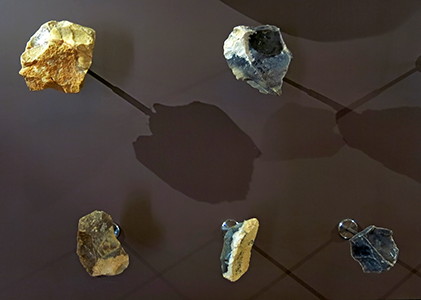
Tools from Grotte Vaufrey, upper part of Layer XI, circa 375 000 BP.
Small scrapers made on flakes, with a burin at top right.
Photo and tool identification: Don Hitchcock 2014
Source: Original, le Musée National de Préhistoire, Les Eyzies-de-Tayac
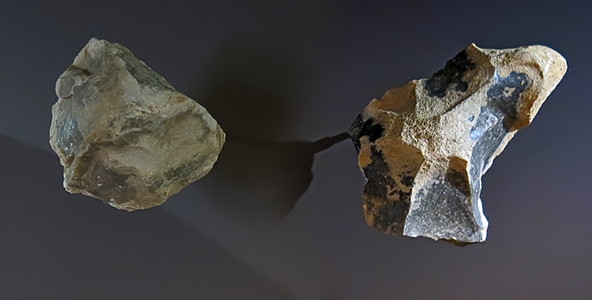
Tools from Grotte Vaufrey, upper part of Layer XI, circa 375 000 BP.
Probably cores from which flakes have been struck.
Photo and tool identification: Don Hitchcock 2014
Source: Original, le Musée National de Préhistoire, Les Eyzies-de-Tayac
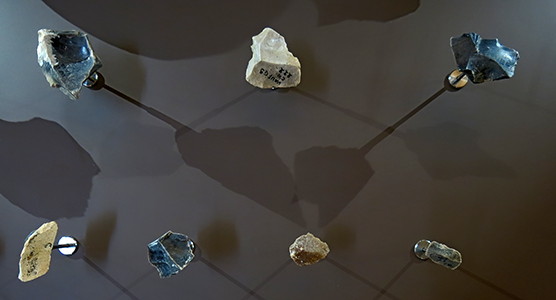
Tools from Grotte Vaufrey, upper part of Layer XI, circa 375 000 BP.
Small scrapers made on flakes, with a burin at top left, with a beautifully crafted hollow for the thumb. This feature is not uncommon with Mousterian tools.
Photo and tool identification: Don Hitchcock 2014
Source: Original, le Musée National de Préhistoire, Les Eyzies-de-Tayac
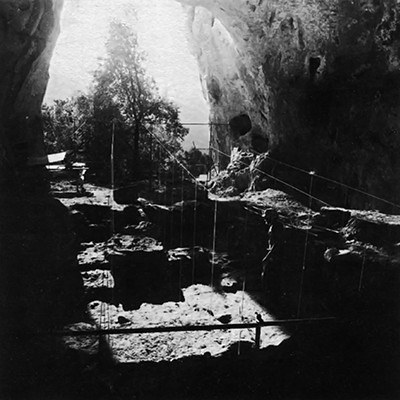
View of the excavation in progress.
( note the worker in the image giving the scale of the dig - Don )
Photo: Rigaud (1988)
Layer X
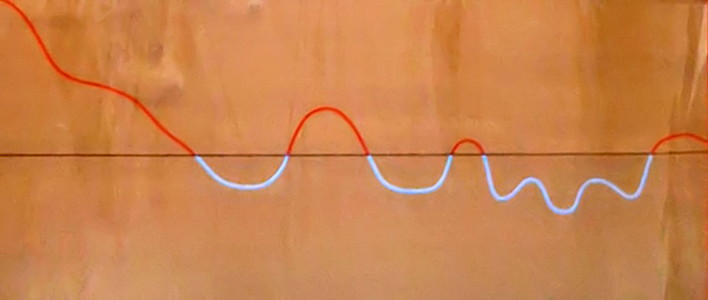
The temperatures of Layer X, circa 325 000 BP, varied considerably during its deposition, from warm to cold.
Layer X included a wide range of fauna such as Deer, Roe Deer, Thar, Bovids, Mosbach horse, and the Etruscan Rhinoceros.
Rephotography of the display: Don Hitchcock 2014
Source and text: Adapted from the display, le Musée National de Préhistoire, Les Eyzies-de-Tayac
Tools from Grotte Vaufrey, Layer X, circa 325 000 BP.
Top row:
A hand axe, apparently unfinished, probably because the right lower edge broke away.
A shame, because the flint is of a particularly beautiful type, with milky blue flint inclusions. Though still a useful tool, it is not finished to the normal standards of such artefacts.
Bottom row:
(left) Lower (smooth) surface of a Levallois flake.
(centre and right) Choppers.
Photo and tool identification: Don Hitchcock 2014
Source: Original, le Musée National de Préhistoire, Les Eyzies-de-Tayac
Tool from Grotte Vaufrey, Layer X, circa 325 000 BP.
Biface nucleiforme, or core shaped hand axe.
Drawing and text: Rigaud (1988)
Photo: Don Hitchcock 2014
Source: Original, le Musée National de Préhistoire, Les Eyzies-de-Tayac
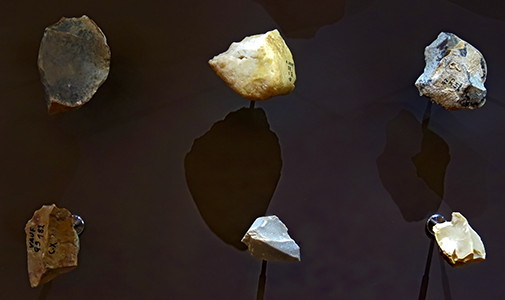 Tools from Grotte Vaufrey, Layer X, circa 325 000 BP.
Tools from Grotte Vaufrey, Layer X, circa 325 000 BP.
Top row:
(left) Lower (smooth) surface of a Levallois flake.
(centre and right) Choppers.
Bottom row:
Three burins.
Photo and tool identification: Don Hitchcock 2014
Source: Original, le Musée National de Préhistoire, Les Eyzies-de-Tayac
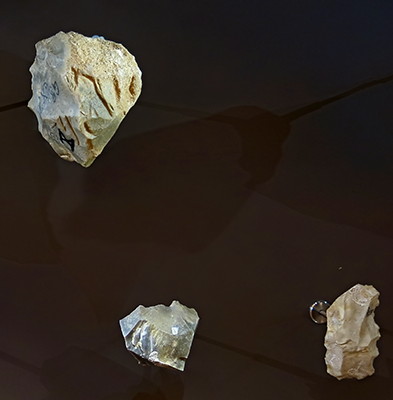
Tools from Grotte Vaufrey, Layer X, circa 325 000 BP.
Top row:
Tridentate scraper on a flake.
Bottom row:
(left): Notched scraper, used to smooth spear shafts, with a possible burin opposite to the notches.
(right): Notched scraper, used to smooth spear shafts.
Photo and tool identification: Don Hitchcock 2014
Source: Original, le Musée National de Préhistoire, Les Eyzies-de-Tayac
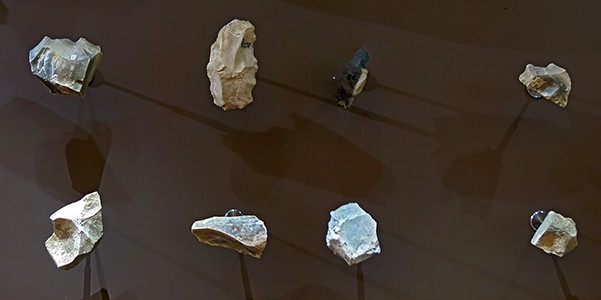
Tools from Grotte Vaufrey, Layer X, circa 325 000 BP.
Top row:
(left): Notched scraper, used to smooth spear shafts, with a possible burin opposite to the notches.
(centre left): Notched scraper, used to smooth spear shafts.
(centre right): small end scraper, with a scraping tool at each end.
(right): Notched scraper and burin.
Bottom row:
(left): Notched scraper.
(centre left): Core?
(centre right): Small round scraper of the raclette type.
(right): Small scraper.
Photo and tool identification: Don Hitchcock 2014
Source: Original, le Musée National de Préhistoire, Les Eyzies-de-Tayac
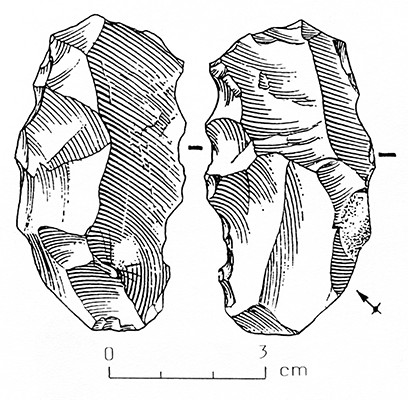
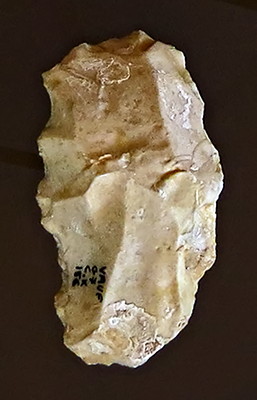
Tool from Grotte Vaufrey, Layer X, circa 325 000 BP.
Denticulate tool.
Drawing and text: Rigaud (1988)
Photo: Don Hitchcock 2014
Source: Original, le Musée National de Préhistoire, Les Eyzies-de-Tayac
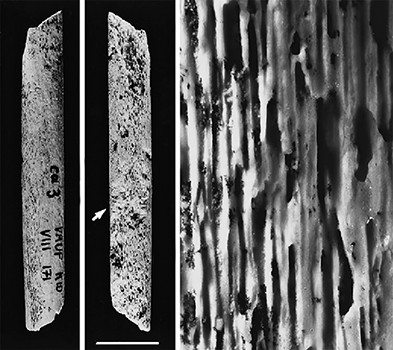
Grotte Vaufrey, layer VIII. Mesial fragment of a possible point described as shaped by grinding. To the right, microscopic view of the bone surface, showing spongy bone exposed by chemical alteration. The arrow indicates recent gnawing by a small rodent.
Photo and text: Villa and d'Errico (2001)
Numbers of identified ungulate specimens, Couche VIII, Grotte Vaufrey
| Numbers of identified ungulate specimens, Couche VIII, Grotte Vaufrey | ||||
|---|---|---|---|---|
| Ungulate | Number | |||
| Aurochs/Bison | 6 | |||
| Mammoth | 1 | |||
| Chamois | 9 | |||
| Horse | 54 | |||
| Red Deer | 833 | |||
| Roe Deer | 7 | |||
| Tahr | 129 | |||
Numbers of identified larger carnivore specimens, Couche VIII, Grotte Vaufrey
| Numbers of identified larger carnivore specimens, Couche VIII, Grotte Vaufrey | ||||
|---|---|---|---|---|
| Carnivore | Number | |||
| Badger | 2 | |||
| Bear | 17 | |||
| Canidae | 26 | |||
| Dhole | 29 | |||
| Fox | 26 | |||
| Lynx | 27 | |||
| Wolf | 2 | |||
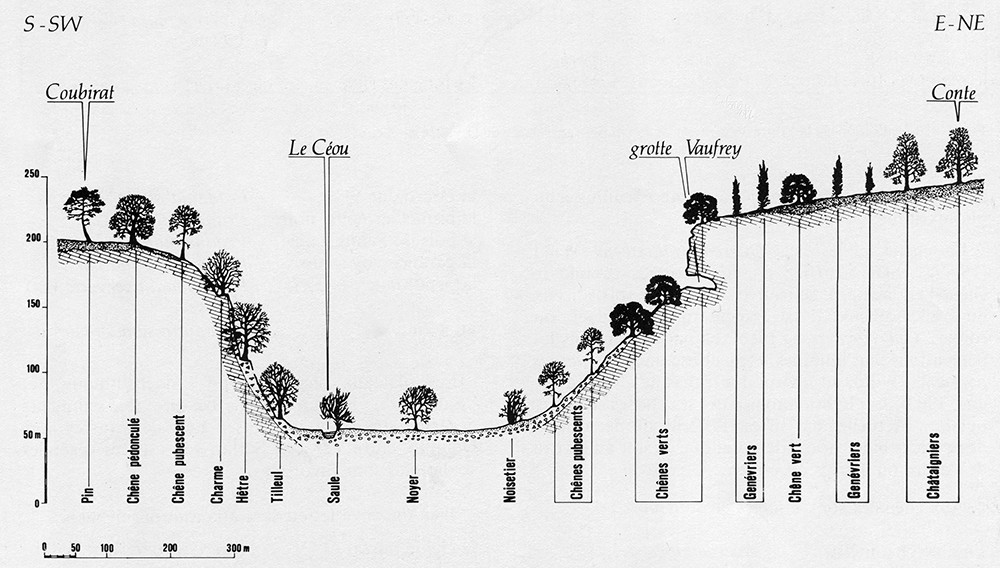
Grotte Vaufrey - Flora in the immediate neighbourhood.
Pin - Pine
Chêne pédoncle - English Oak
Chêne pubescent - Downy Oak
Charme - Hornbeam
Hêtre - Beech
Tilleul - Lime
Saule - Willow
Noyer - Walnut
Noisettier - Hazel Nut
Chêne pubescent - Downy Oak
Chêne vert - Holm Oak
Genévriere - Juniper
Châtaignier - Chestnut
Photo and text: Rigaud (1988)
Layer VII
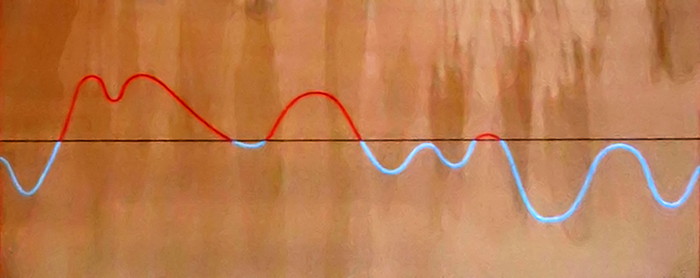
The first half of the depositional period of Layer 7, circa 175 000 BP, was quite warm, but conditions became cold in the second part.
Fauna included Deer, the Mosbach horse and Thar.
Rephotography of the display: Don Hitchcock 2014
Source and text: Adapted from the display, le Musée National de Préhistoire, Les Eyzies-de-Tayac
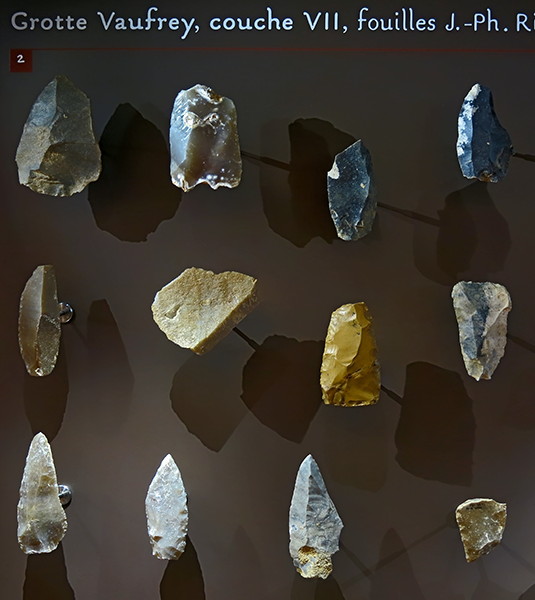
Tools from Grotte Vaufrey, Layer VII, circa 175 000 BP.
■ 2 Racloirs, side scrapers
( Note that many of the tools from Layer VII are made on Levallois type flakes - Don )
Photo: Don Hitchcock 2014
Source: Original, le Musée National de Préhistoire, Les Eyzies-de-Tayac
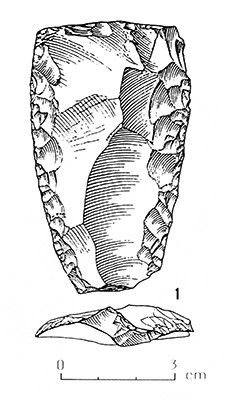
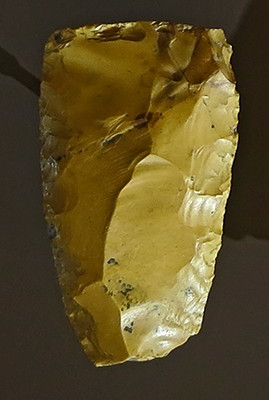
Tool from Grotte Vaufrey, Layer VII, circa 175 000 BP.
Biconvex side scraper (racloir).
( note the beautiful buttery colour and smooth texture of this piece of flint. It must have been a joy to work with. It looks heat treated to improve workability, but this may not yet have been a known technique, given its age - Don )
Drawing and text: Rigaud (1988)
Photo: Don Hitchcock 2014
Source: Original, le Musée National de Préhistoire, Les Eyzies-de-Tayac
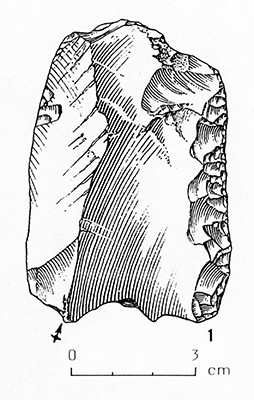
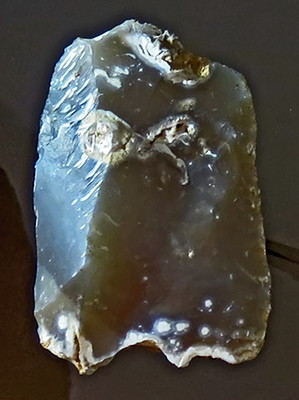
Tool from Grotte Vaufrey, Layer VII, circa 175 000 BP.
Simple convex side scraper (racloir).
Drawing and text: Rigaud (1988)
Photo: Don Hitchcock 2014
Source: Original, le Musée National de Préhistoire, Les Eyzies-de-Tayac
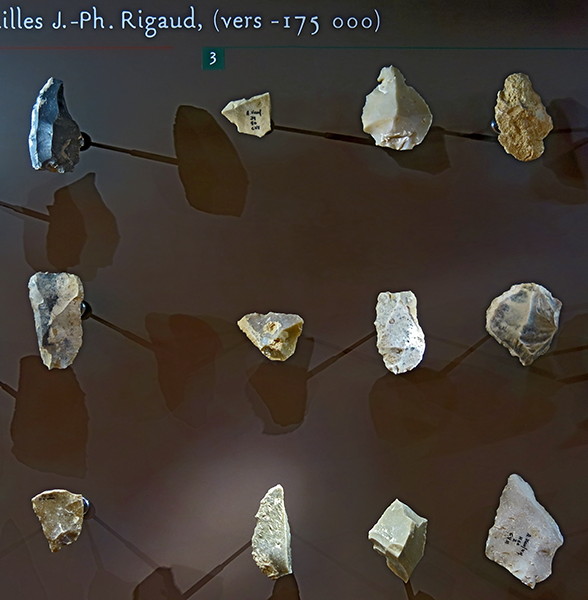
Tools from Grotte Vaufrey, Layer VII, circa 175 000 BP.
■ 2 Racloirs, side scrapers
■ 3 Encoches/denticulés, notched/serrated tools
( note that the artefact at the top right appears to be of limestone, with an imprint of a fossil shell - Don )
Photo: Don Hitchcock 2014
Source: Original, le Musée National de Préhistoire, Les Eyzies-de-Tayac
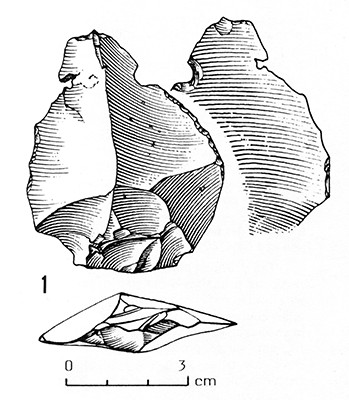
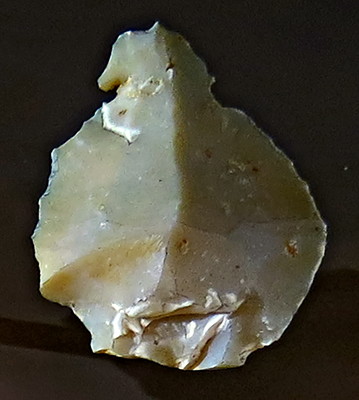
Tool from Grotte Vaufrey, Layer VII, circa 175 000 BP.
Levallois Point in tertiary flint obtained from a deposit near Grotte Vaufrey.
( local flint is often preferred even if it is not of superior quality, simply because it is easily available - Don )
Drawing and text: Rigaud (1988)
Photo: Don Hitchcock 2014
Source: Original, le Musée National de Préhistoire, Les Eyzies-de-Tayac
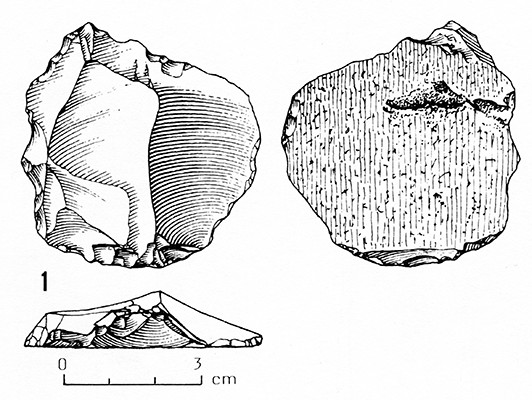
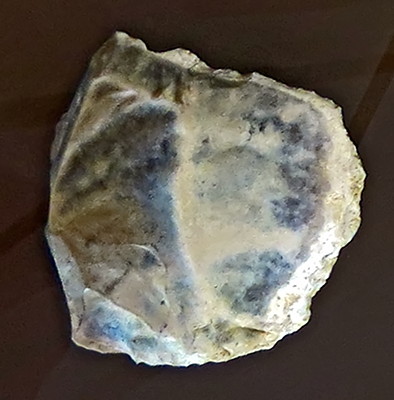
Tool from Grotte Vaufrey, Layer VII, circa 175 000 BP.
Nucleus on a flake, from a flint pebble found in a river bed.
Drawing and text: Rigaud (1988)
Photo: Don Hitchcock 2014
Source: Original, le Musée National de Préhistoire, Les Eyzies-de-Tayac
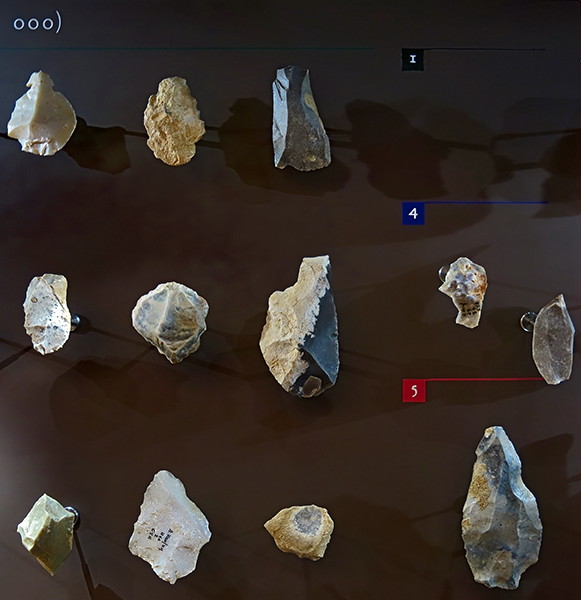
Tools from Grotte Vaufrey, Layer VII, circa 175 000 BP.
■1 Bifaces, hand axes
■ 3 Encoches/denticulés, notched/serrated tools
■ 4 Tools of the upper Palaeolithic type
■ 5 Special tools
( note that the artefact in the top row, second from the left, appears to be of limestone, with an imprint of a fossil shell - Don )
Photo: Don Hitchcock 2014
Source: Original, le Musée National de Préhistoire, Les Eyzies-de-Tayac
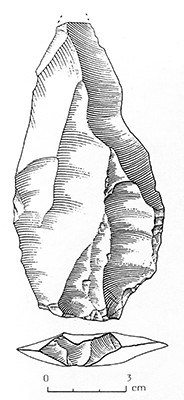
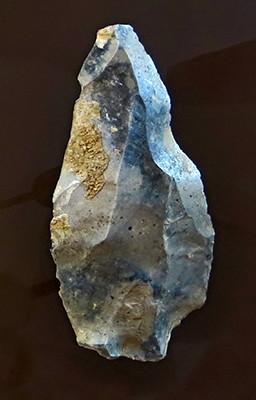
Tool from Grotte Vaufrey, Layer VII, circa 175 000 BP.
Levallois Point.
Drawing and text: Rigaud (1988)
Photo: Don Hitchcock 2014
Source: Original, le Musée National de Préhistoire, Les Eyzies-de-Tayac
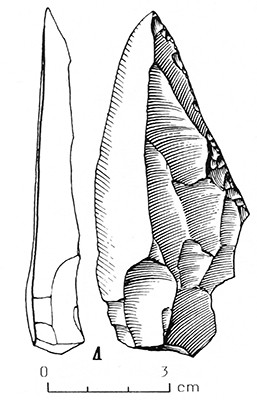
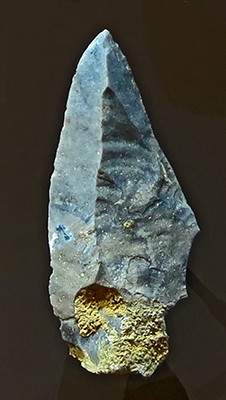
Tool from Grotte Vaufrey, Layer VII, circa 175 000 BP.
Levallois Point.
Drawing and text: Rigaud (1988)
Photo: Don Hitchcock 2014
Source: Original, le Musée National de Préhistoire, Les Eyzies-de-Tayac
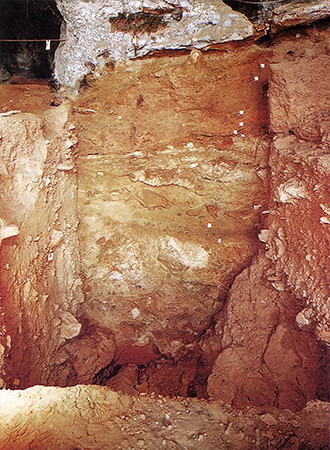
Frontal Coupe.
Photo: Rigaud (1988)
Layer IV
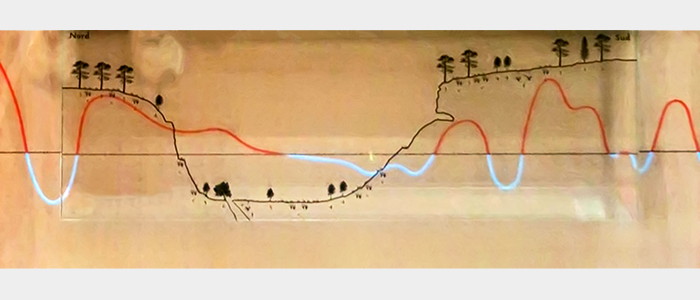
The temperatures for Layer IV, circa 125 000 BP, were warm throughout much of its deposition, but with some cold periods.
Layer IV included a wide range of fauna such as Deer, Roe Deer, Ibex, Reindeer and horse.
Rephotography of the display: Don Hitchcock 2014
Source and text: Adapted from the display, le Musée National de Préhistoire, Les Eyzies-de-Tayac
Flora included the Norway Spruce (Picea abies), Silver Fir (Abies alba), Scots pine (Pinus sylvestris), White Birch (Betula pubescens), Willow (Salix), Lettuce, Chicory, Dandelion, Salsify family (Cichorieae), and grasses.
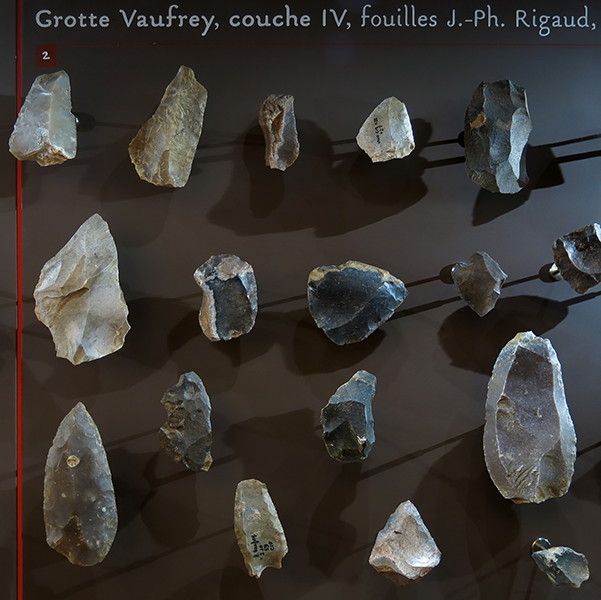
Tools from Grotte Vaufrey, Layer IV, circa 125 000 BP.
■ 2 Racloirs, side scrapers
Photo: Don Hitchcock 2014
Source: Original, le Musée National de Préhistoire, Les Eyzies-de-Tayac
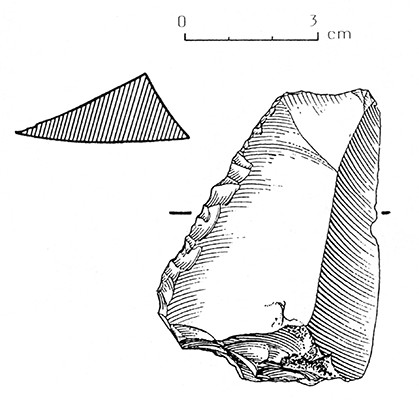
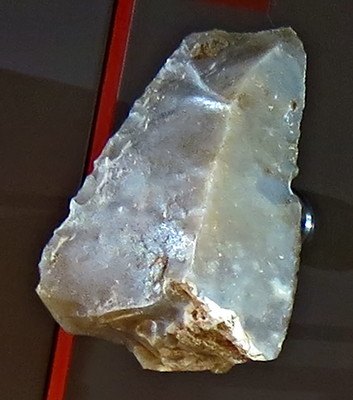
Tool from Grotte Vaufrey, Layer IV, circa 125 000 BP.
Simple convex racloir.
Drawing and text: Rigaud (1988)
Photo: Don Hitchcock 2014
Source: Original, le Musée National de Préhistoire, Les Eyzies-de-Tayac
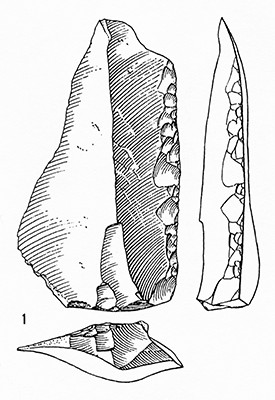
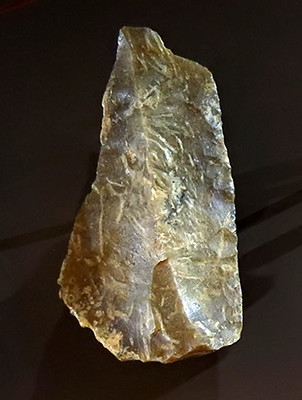
Tool from Grotte Vaufrey, Layer IV, circa 125 000 BP.
Simple straight racloir.
Drawing and text: Rigaud (1988)
Photo: Don Hitchcock 2014
Source: Original, le Musée National de Préhistoire, Les Eyzies-de-Tayac
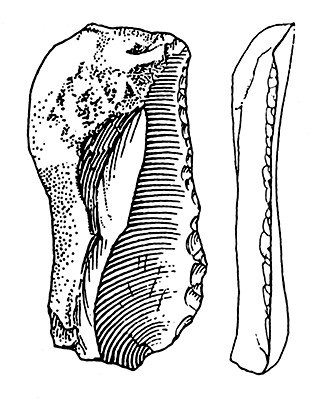
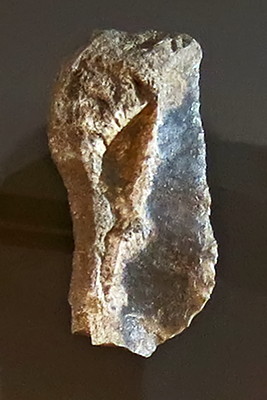
Tool from Grotte Vaufrey, Layer IV, circa 125 000 BP.
Simple convex racloir.
Drawing and text: Rigaud (1988)
Photo: Don Hitchcock 2014
Source: Original, le Musée National de Préhistoire, Les Eyzies-de-Tayac
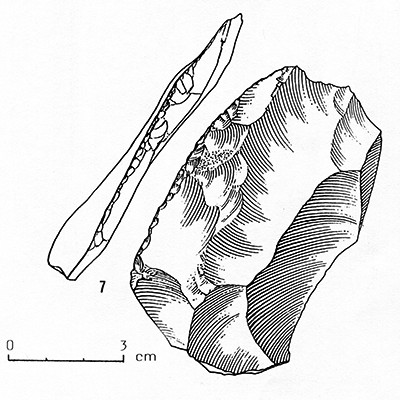
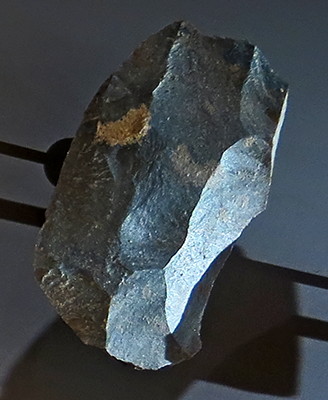
Tool from Grotte Vaufrey, Layer IV, circa 125 000 BP.
Simple convex racloir.
Drawing and text: Rigaud (1988)
Photo: Don Hitchcock 2014
Source: Original, le Musée National de Préhistoire, Les Eyzies-de-Tayac
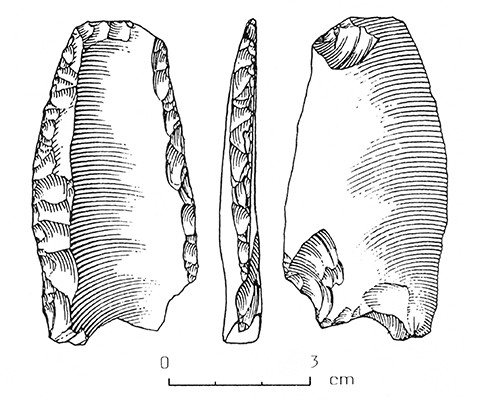
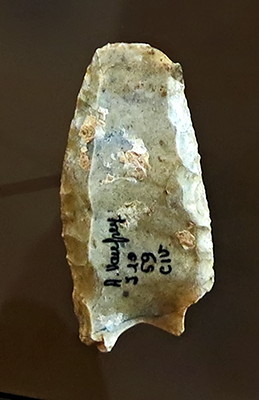
Tool from Grotte Vaufrey, Layer IV, circa 125 000 BP.
Double convex racloir.
Drawing and text: Rigaud (1988)
Photo: Don Hitchcock 2014
Source: Original, le Musée National de Préhistoire, Les Eyzies-de-Tayac
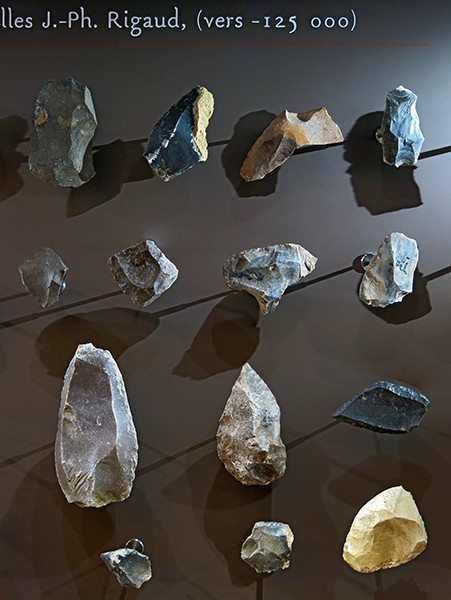
Tools from Grotte Vaufrey, Layer IV, circa 125 000 BP.
■ 2 Racloirs, side scrapers
Photo: Don Hitchcock 2014
Source: Original, le Musée National de Préhistoire, Les Eyzies-de-Tayac
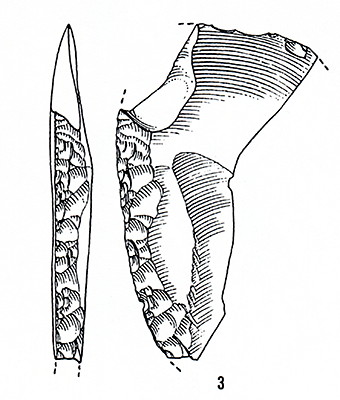
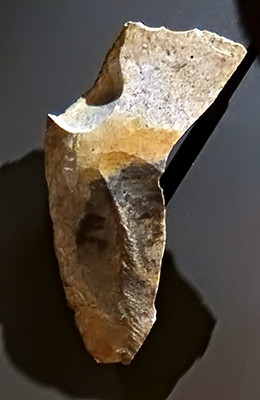
Tool from Grotte Vaufrey, Layer IV, circa 125 000 BP.
Simple convex racloir.
Drawing and text: Rigaud (1988)
Photo: Don Hitchcock 2014
Source: Original, le Musée National de Préhistoire, Les Eyzies-de-Tayac
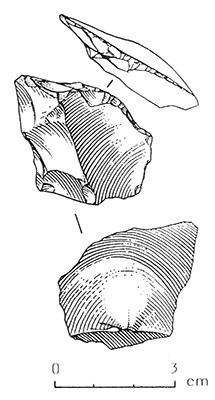
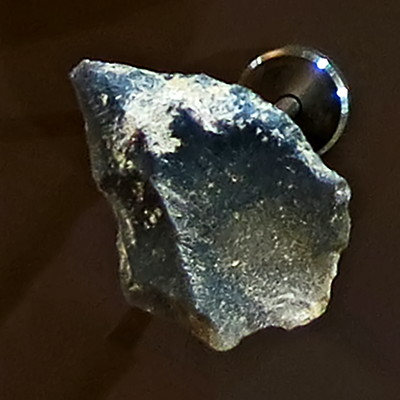
Tool from Grotte Vaufrey, Layer IV, circa 125 000 BP.
Transverse racloir.
Drawing and text: Rigaud (1988)
Photo: Don Hitchcock 2014
Source: Original, le Musée National de Préhistoire, Les Eyzies-de-Tayac
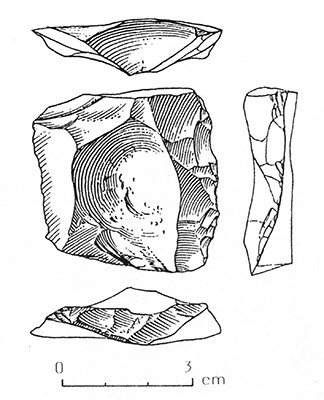
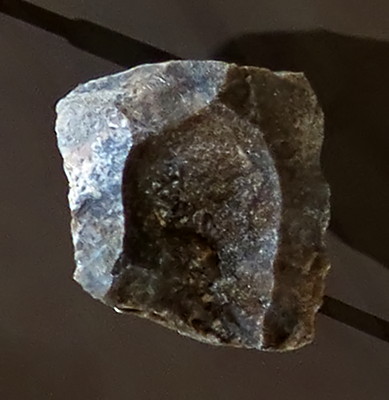
Tool from Grotte Vaufrey, Layer IV, circa 125 000 BP.
Simple convex racloir.
Drawing and text: Rigaud (1988)
Photo: Don Hitchcock 2014
Source: Original, le Musée National de Préhistoire, Les Eyzies-de-Tayac
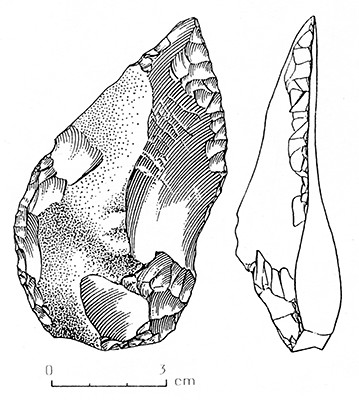
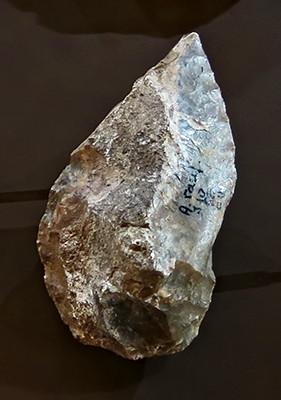
Tool from Grotte Vaufrey, Layer IV, circa 125 000 BP.
Simple convex racloir.
Drawing and text: Rigaud (1988)
Photo: Don Hitchcock 2014
Source: Original, le Musée National de Préhistoire, Les Eyzies-de-Tayac
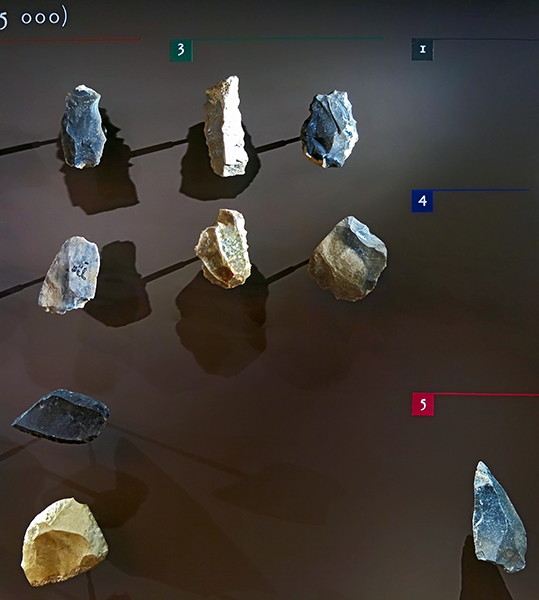
Tools from Grotte Vaufrey, Layer IV, circa 125 000 BP.
■1 Bifaces, hand axes
■ 2 Racloirs, side scrapers
■ 3 Encoches/denticulés, notched/serrated tools
■ 4 Tools of the upper Palaeolithic type
■ 5 Special tools
Photo: Don Hitchcock 2014
Source: Original, le Musée National de Préhistoire, Les Eyzies-de-Tayac
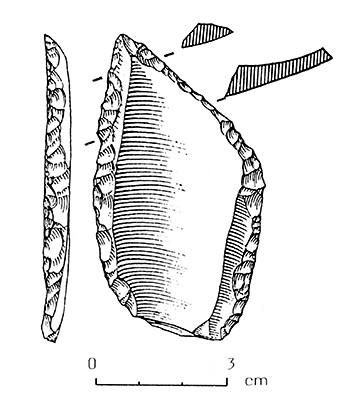
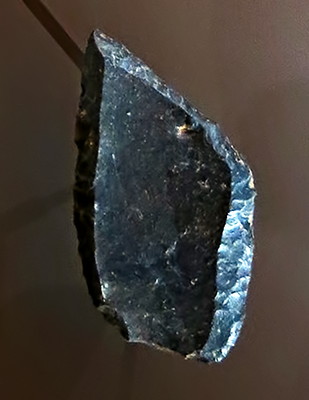
Tool from Grotte Vaufrey, Layer IV, circa 125 000 BP.
Convergent biconvex racloir.
Drawing and text: Rigaud (1988)
Photo: Don Hitchcock 2014
Source: Original, le Musée National de Préhistoire, Les Eyzies-de-Tayac
Layer I
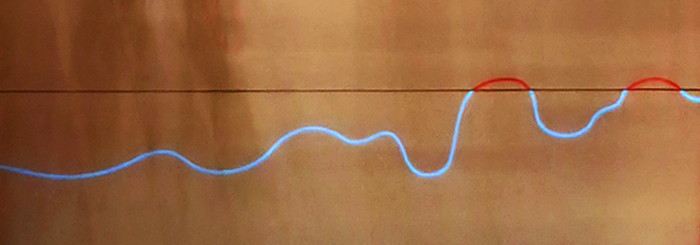
The temperatures during the deposition of Layer I, circa 65 000 BP, were mostly very cold.
Fauna included Reindeer, Deer, Ibex, Horse, Aurochs and Bison.
Rephotography of the display: Don Hitchcock 2014
Source and text: Adapted from the display, le Musée National de Préhistoire, Les Eyzies-de-Tayac
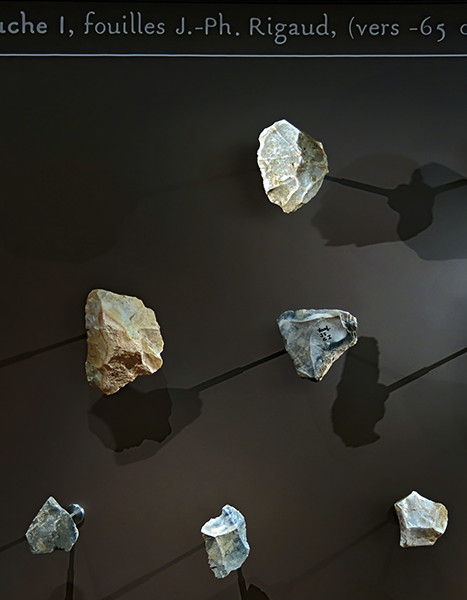
Tools from Grotte Vaufrey, Layer I, circa 65 000 BP.
Simple and notched scrapers.
Photo and tool identification: Don Hitchcock 2014
Source: Original, le Musée National de Préhistoire, Les Eyzies-de-Tayac
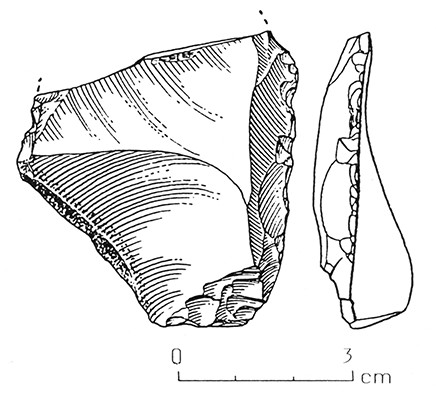
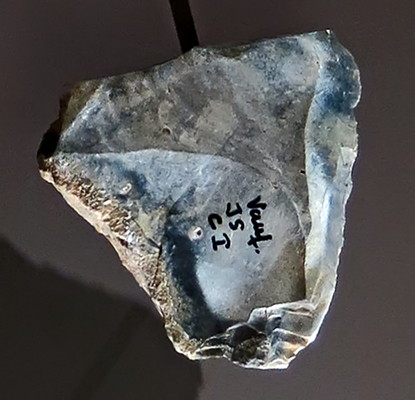
Tool from Grotte Vaufrey, Layer I, circa 65 000 BP.
Simple convex racloir.
Drawing and text: Rigaud (1988)
Photo: Don Hitchcock 2014
Source: Original, le Musée National de Préhistoire, Les Eyzies-de-Tayac
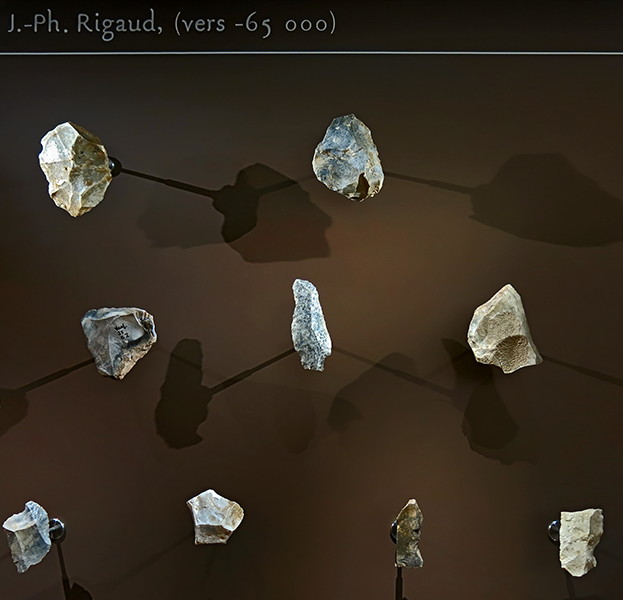
Tools from Grotte Vaufrey, Layer I, circa 65 000 BP.
Scrapers, notched scrapers, and a burin on the bottom row, second from the right, tip broken off.
Photo and tool identification: Don Hitchcock 2014
Source: Original, le Musée National de Préhistoire, Les Eyzies-de-Tayac
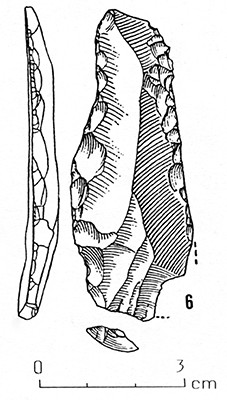
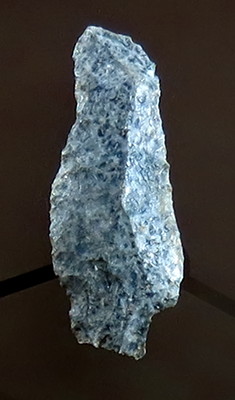
Tool from Grotte Vaufrey, Layer I, circa 65 000 BP.
Double racloir.
Drawing and text: Rigaud (1988)
Photo: Don Hitchcock 2014
Source: Original, le Musée National de Préhistoire, Les Eyzies-de-Tayac
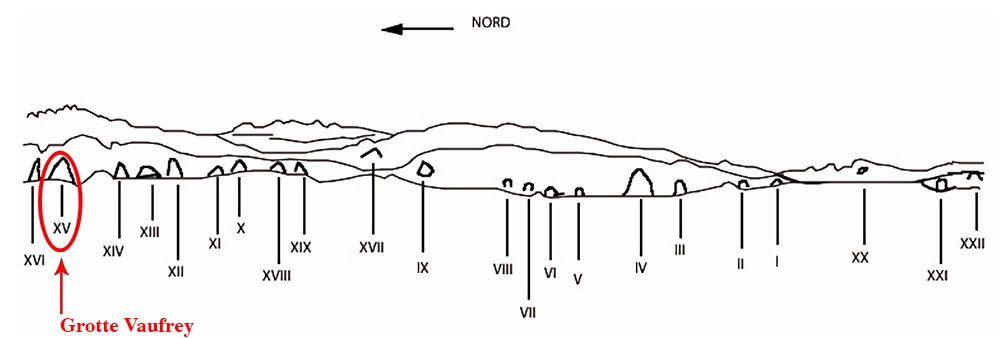
Position of the caves on the Falaises du Conte, the western face of the Massif du Conte, with the location of la Grotte Vaufrey marked.
Photo: after Guadelli J.-L. et Rigaud (1995)
Text above: Guadelli J.-L. et Rigaud (1995)Les sites du Massif du Conte (Dordogne)
From south to north we meet the following caves:
XXI Cave or Badgers Cave. This cavity was formerly arranged, but J. Lachastre and one of us (J.-Ph.R.) thereafter, have found only historical remains.
- Cave XX, speleological interest.
- To these caves, we will add two more located at the southern end of the escarpment, visited during prospections: Cave XXII which presents for the moment that a speleological interest and the cave XXIII which, by its dimensions, does not seem to be suitable for human occupation. It is not excluded, however, that these two caves may contain remains of quaternary animals.
- Caves I and II have not delivered prehistoric evidence.
-Greater III delivered to E. Harle and H.G. Stehlin (1913) a fauna most likely dated to the Middle Pleistocene.
- Shelter IV or "Black Cave" is a vast rock shelter more than 15 m wide and ten meters deep occupied by a house that was still inhabited in the mid-nineteenth century. Lapeyre and Nouel searched there in 1932 and 1933. The critical study of the publication of these researches (Lapeyre and Nouel, 1934) and the results of a survey carried out in 1966 make it possible to advance that the shelter IV contained probably a level Mousterian at the base, surmounted by several Aurignacian levels and a Perigordian level (Rigaud, 1982). Unfortunately, the deposit is almost completely destroyed.
-The cave V: without archaeological interest.
- Cave VI or Grotte des Fours is a gallery with two entrances parallel to the cliff with still visible traces of "Catalan forges". Apart from fragments of pottery and flint objects attributed to the Chalcolithic (?) (Lachastre, 1968), this cave has not delivered Paleolithic remains.
- Shelter VII: without archaeological interest.
- Cave VIII or Cave of the Necklace. This cave is constituted by a terrace extending by a room then a sloping corridor strewn and obstructed with stones. During surveys, J. Lachastre discovered on the surface, fragments of shells (cardium) and a sounding allowed later to collect the remains of a burial buried by burrowing animals.
Two other surveys carried out by M.-C. Cauvin led this author to attribute some of the ceramic material to a hunting occupation (Cauvin, 1971).
- Cave IX. Cliffside so far without prehistoric remains.
- Shelter XVII is a shelter on the cliff without vestiges.
- Cave XIX, no known archaeological interest.
-The cave XVIII is a shelter that has delivered on the surface fragments of pottery may be Neolithic.
- The caves X and XI or caves of the Red Rock communicate by a narrow gallery and are encumbered with scree making the exploration dangerous. Without known archaeological remains.
- The cave XII. This cave communicates through a gallery with the next.
- Cave XIII or Cave of the Church is quite large and contains important ossiferous levels which were searched by F. Prat with the collaboration of Cl. Thibault. Based on data from paleontology and sedimentological analysis, the filling of this cave is placed chronologically between the Würm and the upper Mindel (Laville, Prat and Thibault, 1972).
-The cave XIV, preceded by a rather high porch, contains important ossiferous mullions unfortunately ransacked by collectors of bear teeth. Excavations carried out by one of us (J.-L.G.) allow to attribute an age mindelian to a fauna containing in particular Ursus deningeri, Panthera gombaszoegensis and Thar.
-The cave XV or Vaufrey cave was searched in 1930 by R. Vaufrey then systematically from 1969 to 1982 by one of us (J.-Ph. R.). The excavations revealed a succession of archaeological levels enclosing an industry of average Paleolithic type.
Cave XVI or Grotto of pottery. It consists of a large room more than 20 m long and 7 m wide open to the west that extends a gallery of ten metres long. A first survey by J. Lachastre in 1960 yielded ceramic remains attributed by this author to Chalcolithic and excavations that one of us led (J.-Ph.R.) in this cavity since 1983 have highlighted archaeological levels of Upper Paleolithic and Middle Paleolithic.
This cave is the last known of the rocky escarpment of the Conte Massif bordering the Céou.
References
- Bennett D., 1992: Origin and distribution of living breeds of the domestic horse. Pp. 41-61, in Horse breeding and management, Evans W., ed., World Animal Science, C7. Elsevier, Amsterdam, 417 pp.
- Bennett D., Hoffmann R., 1999: Equus caballus, in Mammalian Species, No. 628, pp 1-14, 4 figs., published 3 December 1999 by the American Society of Mammalogists
- Bezemer M., 2012: The influence of climate on artefacts Neandertal adaptability visible in the archaeological record, MA Thesis 0628107 Wil Roebroeks Palaeolithic Archaeology Leiden University Faculty of Archaeology, Leiden, 12 June 2012
- Grayson D., Delpech F., 1994: The evidence for middle palaeolithic scavenging from couche VIII, Grotte Vaufrey (Dordogne, France), Journal of Archaeological Science, (1994) 21, pp. 359-375
- Guadelli J.-L., Rigaud J.-P., 1995: Les sites du Massif du Conte (Dordogne), Les Cahiers de la Vallée de la Couze, CIRC, Montferrand-du-Périgord, 1995, 6, 17p., 3 fig.
- Kervazo B., Laville H., 1989: Etude stratigraphique et analyse phisico-chimique des depots de la Grotte Vaufrey, in: J.-P. Rigaud (ed), La grotte Vaufrey: paléoenvironnement, chronologie, activités humaines, Paris: Société Préhistorique Française. 89-153.
- Kervazo B., Texier J.-P., 2009-2010: Le site paléolithique de la grotte XVI (Dordogne, France) :lithostratigraphie, processus de formation et essai de chronologie, Paléo, n°21, p. 163-188
- Mellars P., 1996: The Neanderthal Legacy: An Archaeological Perspective from Western Europe, Princeton University Press, 1996 - History - 471 pages
- Rigaud J.-P., 1988: La Grotte Vaufrey à Cénac et Saint-Julien (Dordogne): Paléieoenvironnements, Chronologie et Activités Humaines, Mémoires de la Société Préhistorique Française, 19, pp. 593-611
- Villa P., d'Errico F., 2001: Bone and ivory points in the Lower and Middle Paleolithic of Europe, Journal of Human Evolution, August 2001, 41(2):69-112 DOI10.1006/jhev 2001.0479 SourcePubMed.
Back to Don's Maps
 Back to Archaeological Sites
Back to Archaeological Sites
